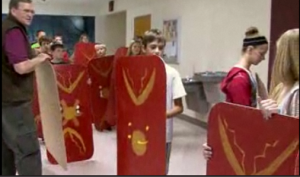For Hileman, the idea of creating an atmosphere of collaboration in the classroom is key. He uses textbooks only as a diving board to explore subjects in depth, and he's always looking for a new angle to a story -- something his students -- or even he -- didn't necessarily know about. "We’re [all] on the trail of learning together," he said. "I’m going a little farther ahead so I can facilitate... but we’re all learning."
In Clearwater, Florida, fifth-grade teacher Tracy Daly demonstrated the difference between kinetic and potential energy by using a small ball pendulum. The audience watched her students design and build miniature roller coasters with classroom supplies.
"My students need to see how things work in the real world," she said. "They’re curious and I take advantage of that. And they have a blast while doing it."
In response to a question about her class's test score, she said she can see when her students are learning by watching them create these projects. "Just because my test scores haven’t been to the expectation, doesn’t mean my students haven’t shown growth," she said.
Fourth-grade teacher Kristin Casareto from Oakland, Calif., gave her students the opportunity to take on the teacher's role in order to boost leadership skills.
"They know that their voice is just as respected as any teacher in this school," she said.
These exhibitions of innovative teaching practices are a far cry from how most classrooms have been portrayed by major media. But these teachers were hailed as heroes to the audience, and they were featured alongside Salman Khan and the start-up entrepreneurs of the Innovation Challenge who launched Class Dojo and Kickboard -- names we're more likely to see at ISTE than through mass media outlets with such a far reach. Online, the coverage tallied more than 1.6 million page views, according to NBC.
The topic of technology and learning was also a big highlight.
"We’re at a crossroads on figuring out how to leverage technology to change instruction -- are we using it just as a device in the classroom?" asked John King from New York Department of Education during one of the panels. "I see kids actually learning differently because of the computer. But in other classes, I see kids doing worksheets on the screen, which is not really that different from what they've been doing."
Mobile phones and mobile devices will likely become more prevalent, he said, as schools start experimenting with different learning environments. And computer labs may soon be a thing of the past.
Pat Yongpradit, a computer science teacher at Springbrook High School in Silver Spring, Maryland, said he sees mobile technology changing the learning landscape, where smart phones can be used to access any information and learning can happen anywhere at anytime, not just in schools.
"We’re a couple of years away to get to point at which point most people will have mobile devices that can bring up a Web site," he said. "But when that happens, innovative educators will use that to its full extent."
Yongpradit brought up the Flat Classroom Project, where students from collaborate globally on solving problems together. "Educators all over the nation are using different sites and apps to connect students across the country and outside this country," he said. "It can only lead to good things. At the very least, it will help kids be more selfless and aware. It's students solving real-world problems using technology for the good of humanity."
Yongpradit proposed an idea: use the premise of the Innovation Challenge -- asking young entrepreneurs to find viable ways of solving problems -- and apply it to all high school students around the country.
"It' not just using technology, but become creators of technology," he said. "Even at a young age, they can do something with technology to help the world."


